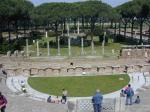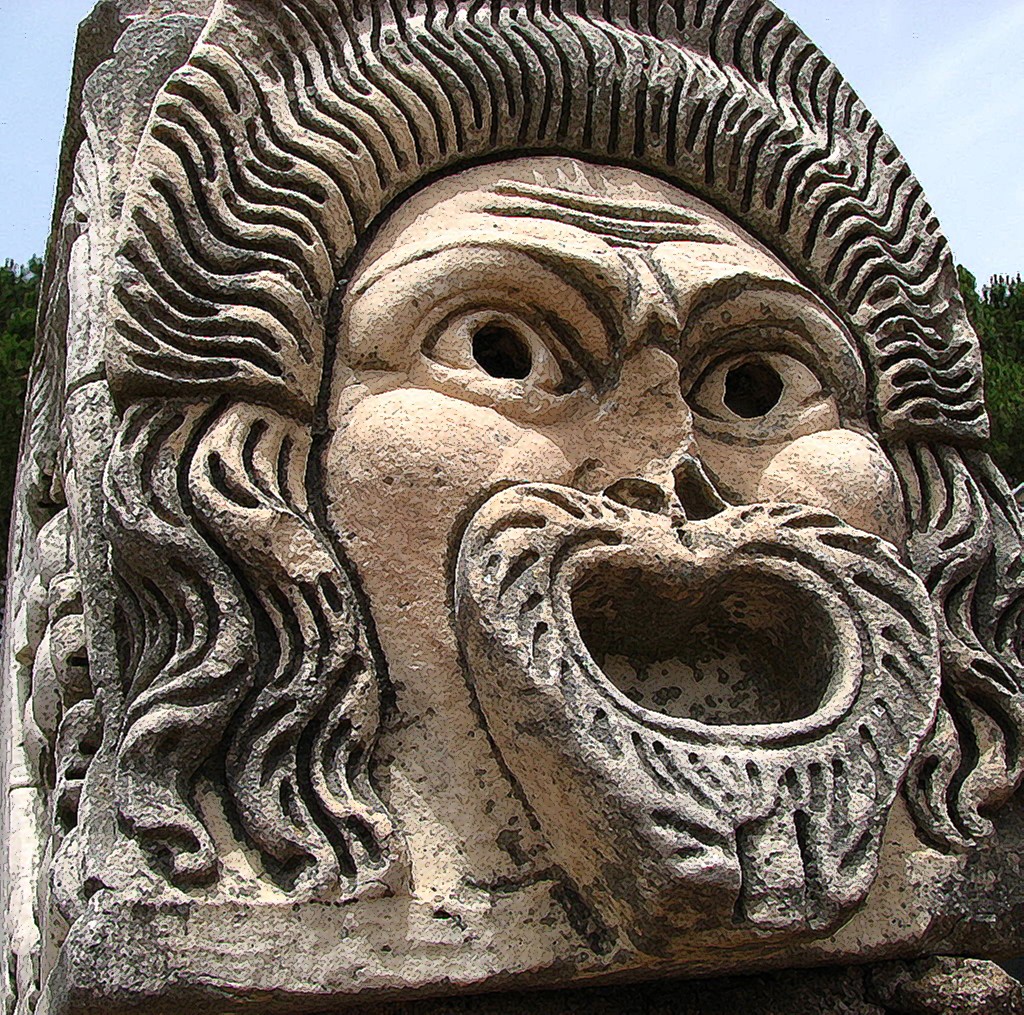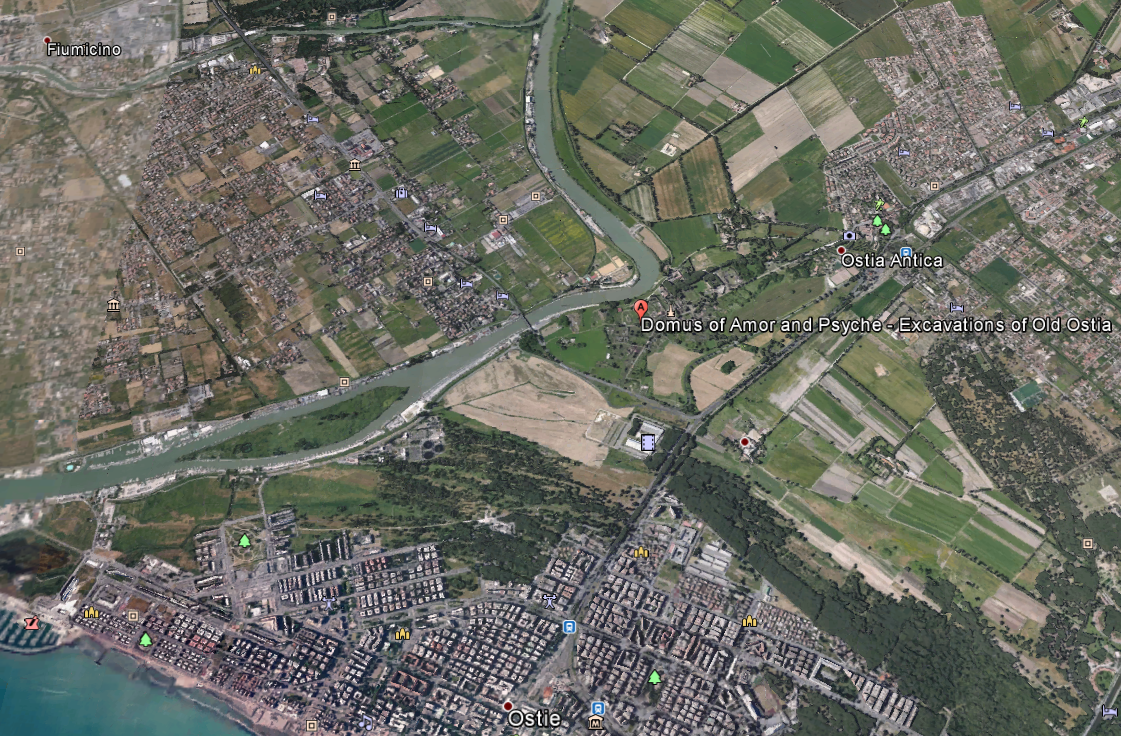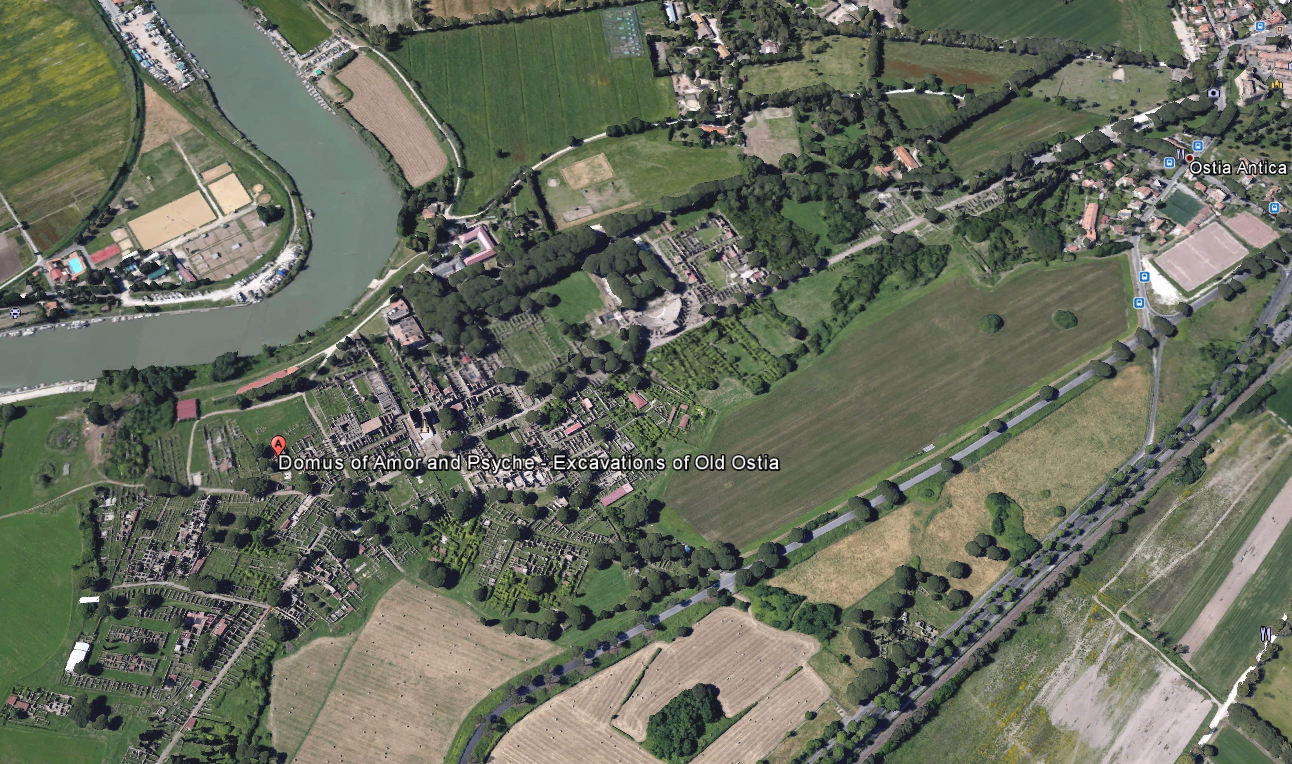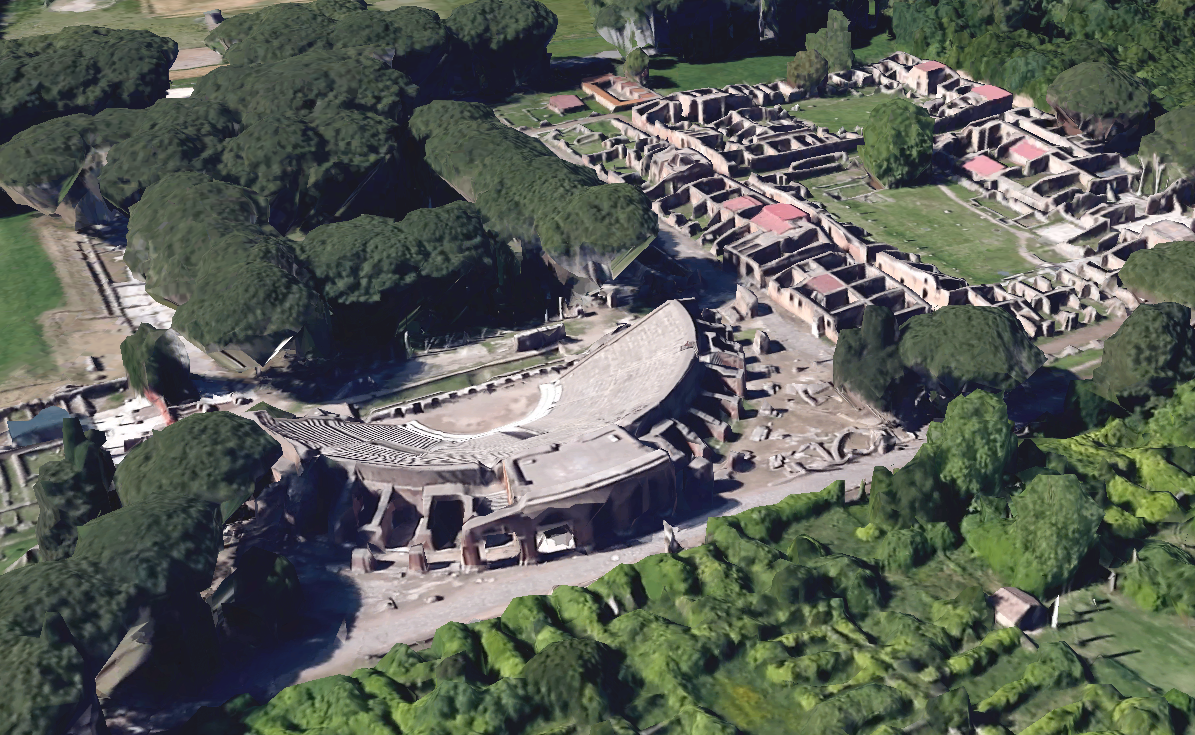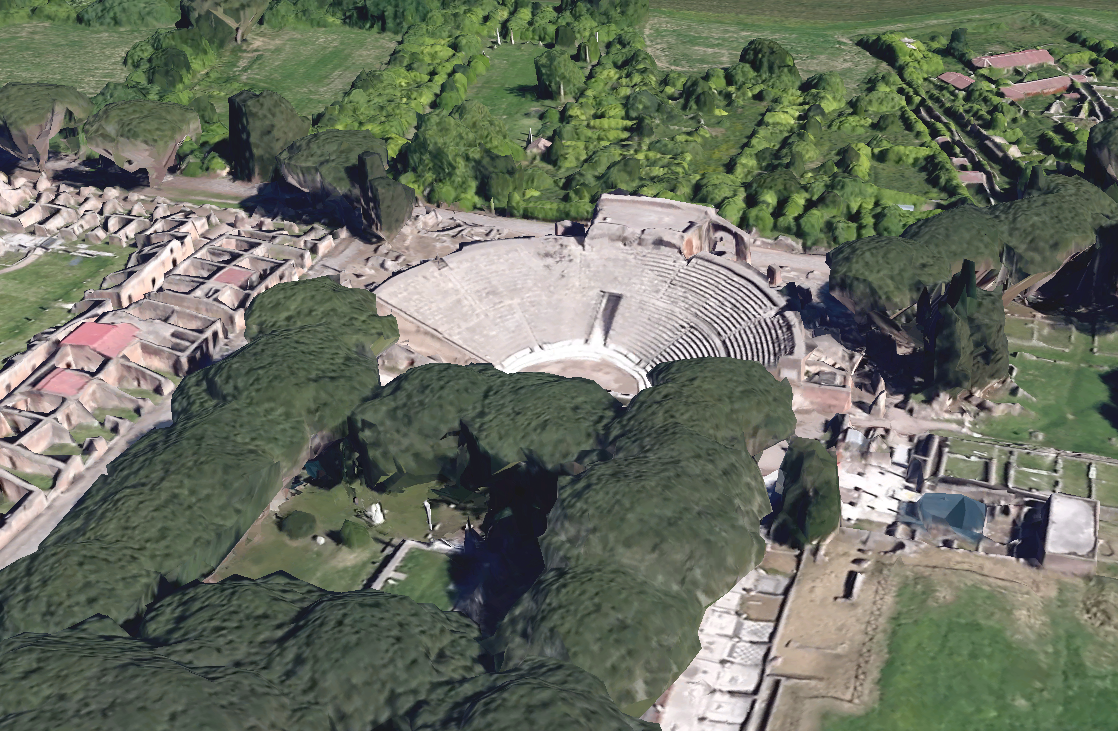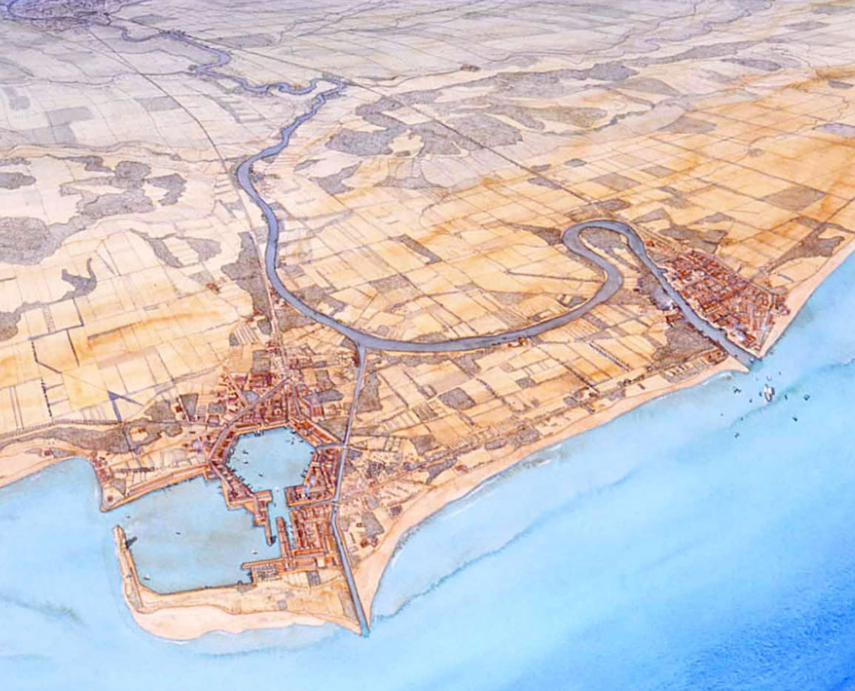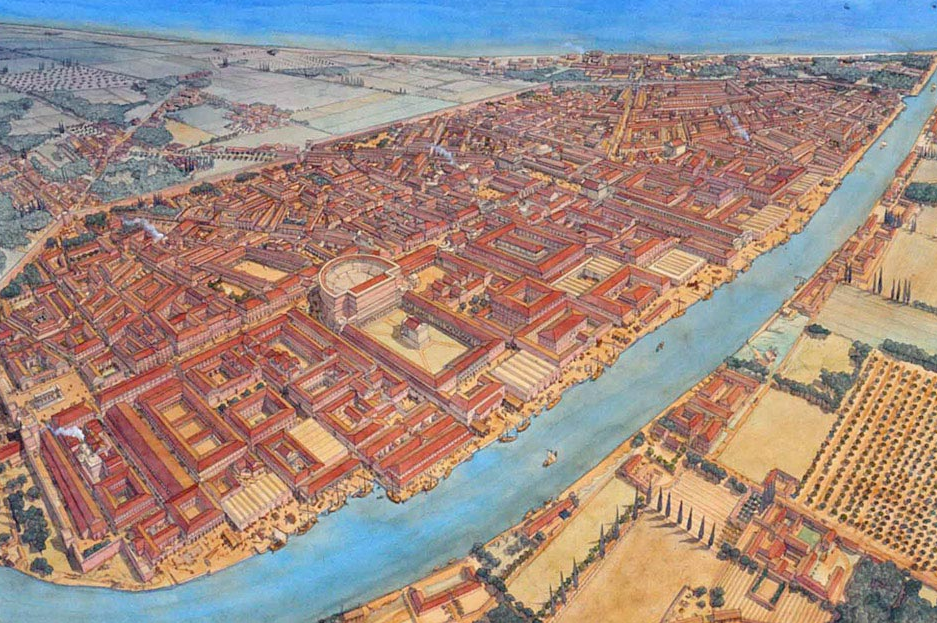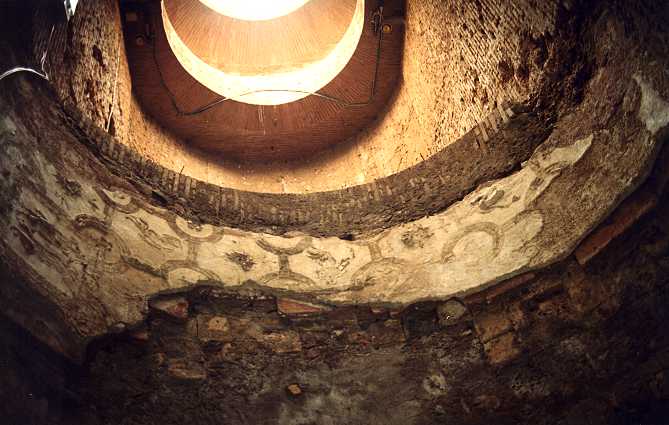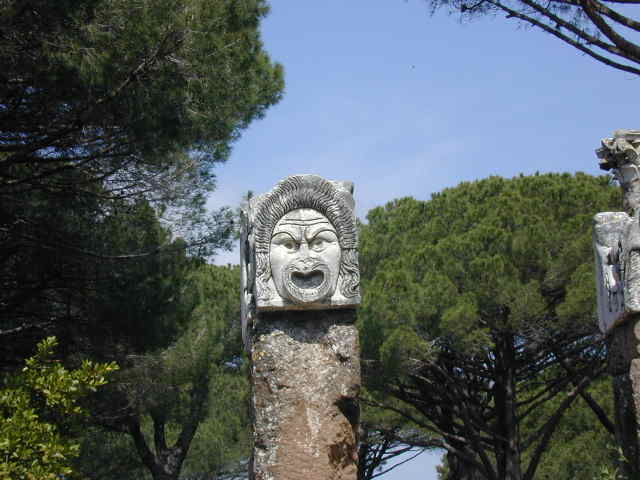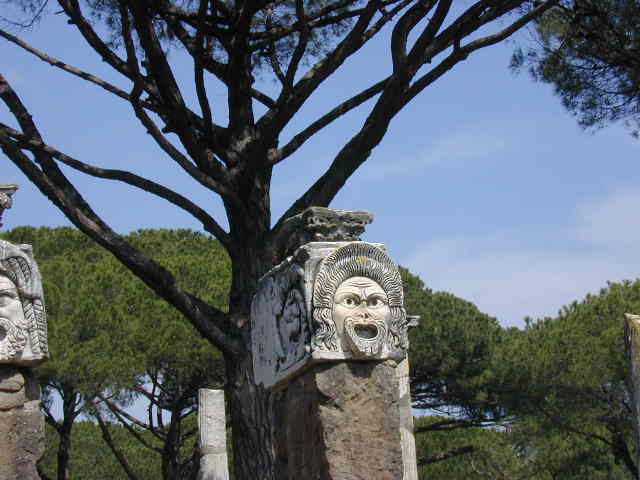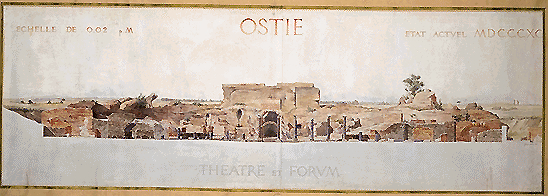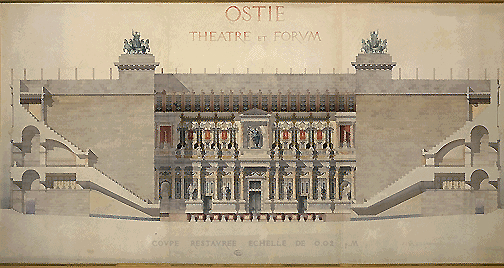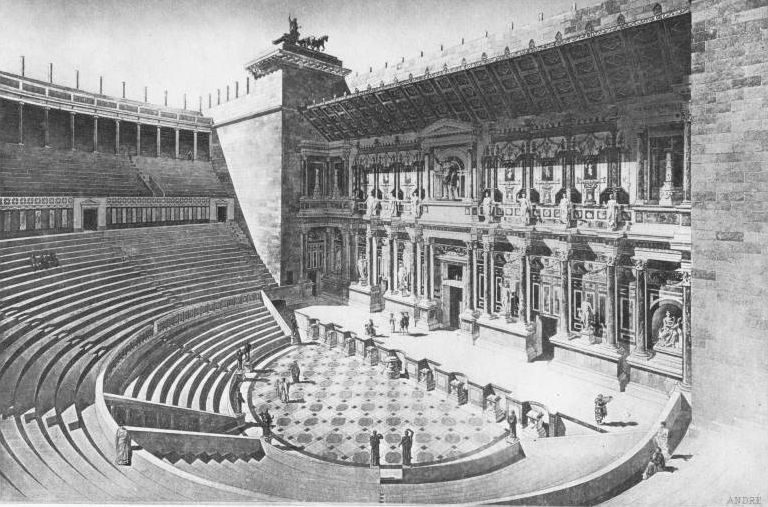Ostie Théatre
English Translation
Historique Voir ICI
History Click HERE
Traduction de cet article
Regio II - Insula VII - Teatro (II,VII,2)
Il faut savoir que dès l'origine les fouilleurs ont divisée Ostia en 5 regions, numérotées .ensuite dans les regions on a invidualisé des insulae et des bâtiments individuels numérotées comme suit: région I bloc I bâtiment 1 etc.
Le théâtre a été construit le long du Decumanus Son emplacement a été decouvert au début du 19ème siècle. Il a été fouillé dans les années 1880-1881, 1890, et au début du 20ème siècle. Le bâtiment a été tre restauré.
Les fragments d'une inscription nous disent qu'un premier théâtre a été construit à la fin du premier siècle avant J.-C. par Agrippa, le beau frere d'Auguste en opus reticulatum et en grands blocs de tuf . Il pourrait contenir 3000 spectateurs. Au nord du théatre se trouve la place des Corporations (II, VII, 4).
Le théatre actuel a était construit à la fin du IIe siècle de notre ère. On a profité pour l'agrandir et il pouvait accueillir 4000 personnes. Nous avons trouve une grande inscription datant de 196 . A l'origine des lettres en bronze y étaient insérées
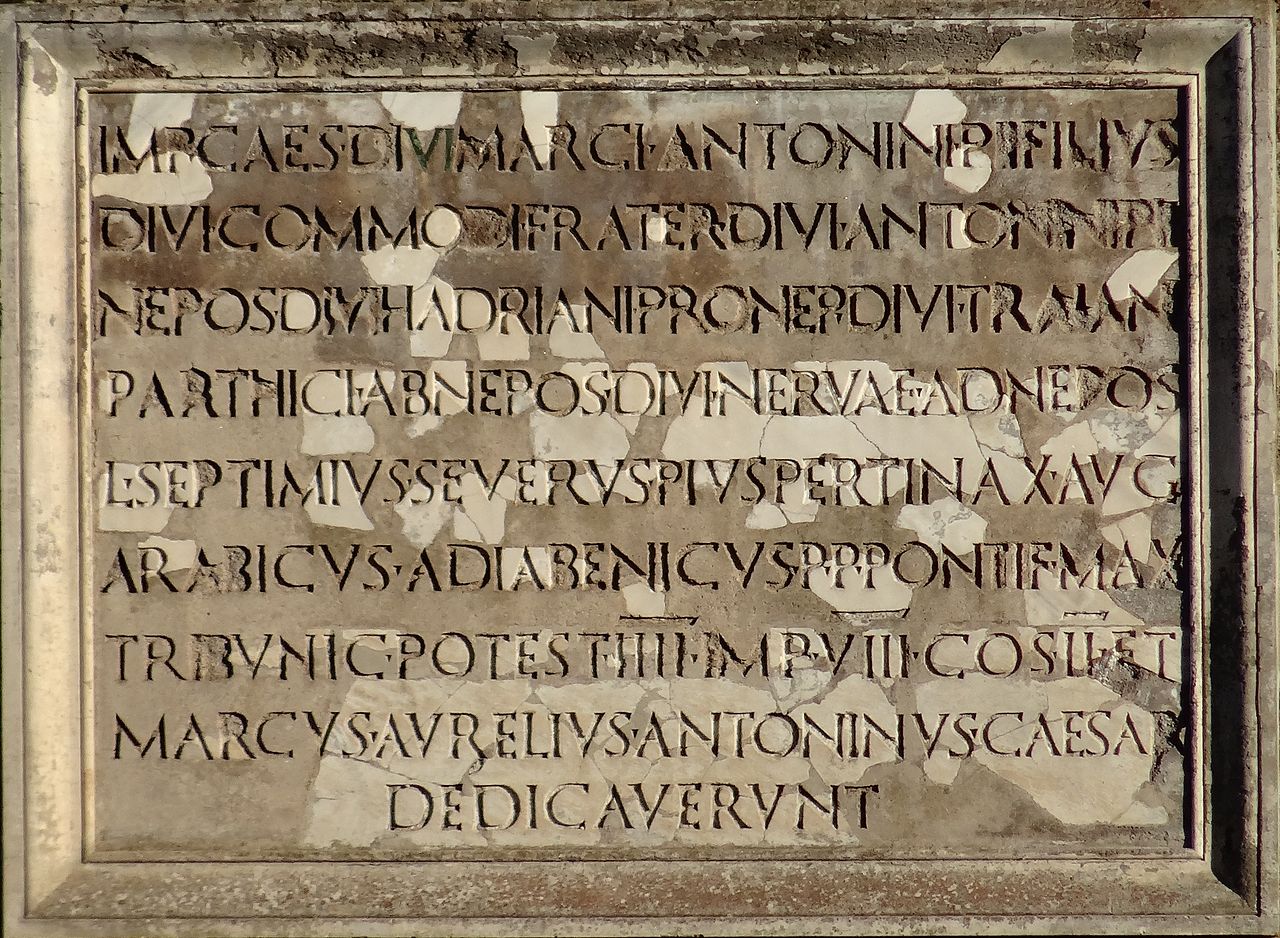 |
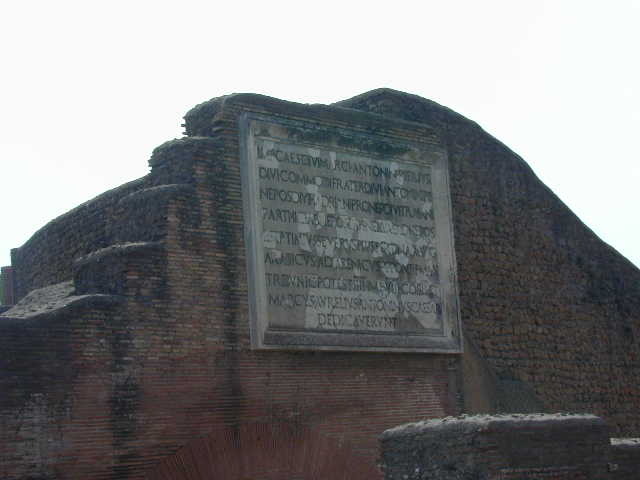 |
 |
Le texte nous indique que cette reconstruction a été l'œuvre de Septime Sévère et Caracalla. Par contre des empreintes sur les briques nous poruvent que la construction avait commencé sous le regne de Commode (176-192 ).
doit on y voir une relation avec la re-fondation d'Ostie par Commodus comme Colonia Felix Commodiana, datant probablement dans les années 190-192 . il avait d'ailleur refondé en lui donnant son nom la ville de Lanuvium où il est né et pour faire bien Rome
Le théâtre était un excellent symbole pour célébrer la fondation de sa nouvelle colonie d'autant que Commode avait une passion pour les gladiateurs, et il a peut-être paru dans le théâtre comme gladiateur, ou y tuer des animaux sauvages, comme il le faisait à Rome et Lanuvium. D'ailleurs il a éé trouvé lors de fouilles du théatre une statue de Commode associé à Hercules, aisniq qu'un bas relief en stuc d'Hercule, couronné par Victoria
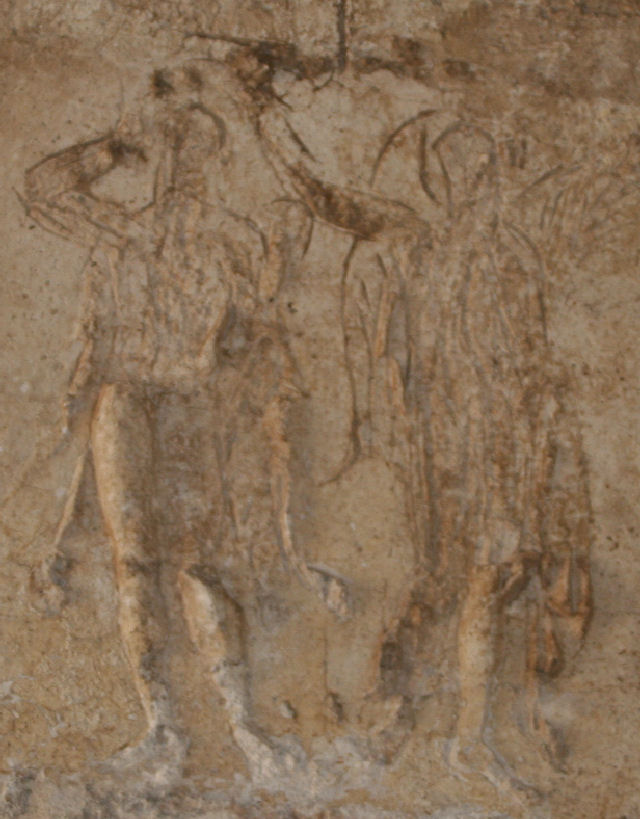 |
Un texte faisant probablement référence au théâtre d'Ostie et datant de 197 nous mentionne que lors d'une intervention devant le Sénat Septime Sévère a déclaré "Il est en effet honteux pour lui [Commodus] de tuer de ses propres mains des bêtes sauvages, mais à Ostie l'autre jour un il a été vu un vieil homme qui avait consul se promenant à la vue de tous avec une prostituée qui imitait un léopard ". Ce texte doit faire reference aux célébrations de la re-fondation de Ostie par Commode
Il doit aussi parler de l inauguration du nouveau théâtre en 196
Desccription
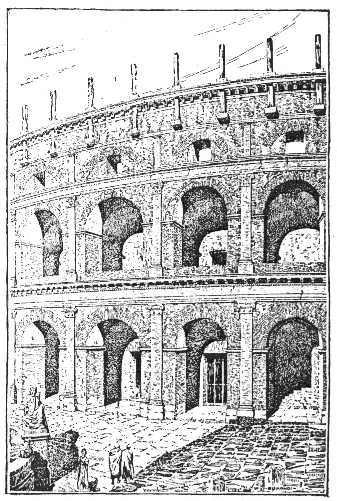 |
Le nouveau théâtre a été refait en briques. La façade est tournée vers le decumanus En face on trouve deux nymphaea (II, VII, 6-7). Cette zone pavée de travertin était entourée par une coonnade avec des piliers de travertin,sur lesquels étaient fixées des chaînes.
Sur la façade ont trouve 16 magasins avec arrière-salles. Les magasins étaient décorés avec des peintures murales . on y accédait par un portique soutenant un arc . Entre les arches se trouvait des pilastres en briques sur base de travertin.Pour les 2e et 3e nivaux nous avons le même style.Le 3 niveau possédait des des fenêtres). A l 'entrée sur le portique, de l'entrée principale,se trouvait un puits avec margelle en travertin datant du regne de Commode
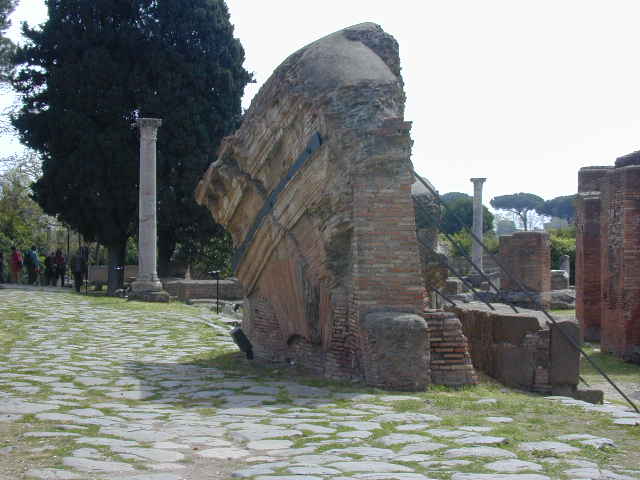 |
On accédait au niveau inférieur par le Decumanus Le théatre avait une entrée centrale , et deux latérales. L'entrée centrale avait un revêtement sol et mur en marbre. La voûte était décorée avec des reliefs en stuc. Quatre escaliers entre les magasins conduisent au 2e et 3e niveau.
Le coin salon pourrait être ombragé par un auvent, suspendu à des poteaux insérés dans des blocs de travertin. Les sièges eux-mêmes devaeint été à l'origine en marbre. Au troisième niveau se trouvait une colonnades en marbre Celle ci lors de la restauration est on été deplacées derrière la scène.
L'orchestra possèdait un sol en marbre. Sur le devant de la scène se trouve le mur avec des 5cin demi cercles et 4e niches rectangulaires, décorées avec du marbre, y compris une corniche et de petites colonnes
Le mur du fond de la scène a disparu presque complètement. Sur la scène quelques masques en marbres decorant le theatre ont été retrouvés.
A la fin du IVe siècle Ap JC le bâtiment a été restauré par le préfet de l'Annone, Ragonius Vincentius Celsus. Une statue de Roma fut érigée durant cette période érigée au sud-est du théâtre.
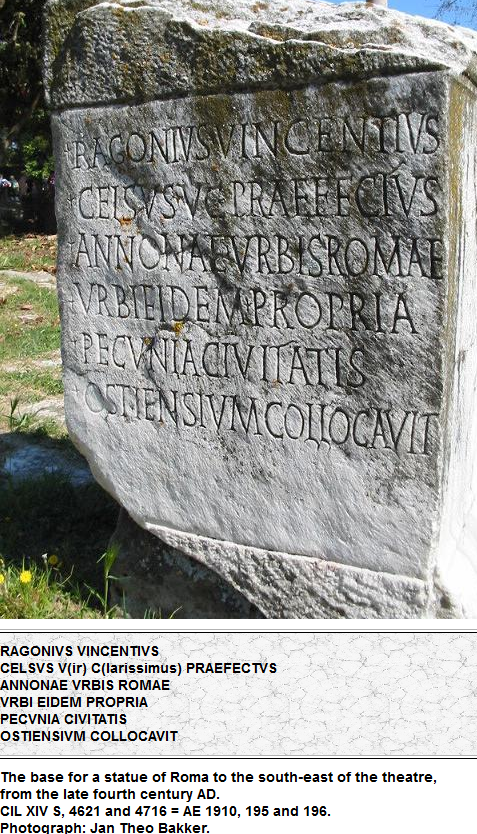 |
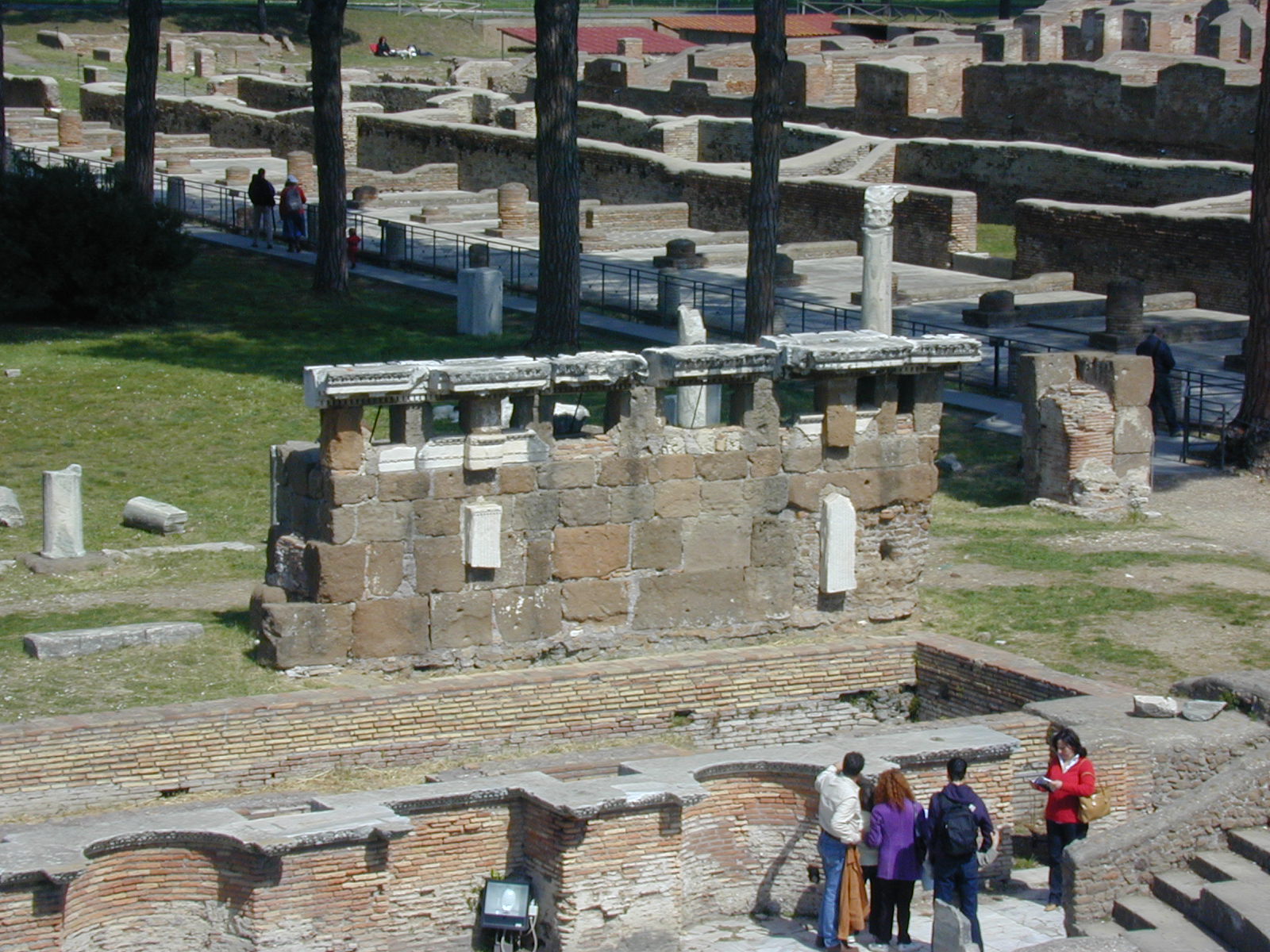 |
L'orchestra et la scèna ont été reliés à deuxs niches rectangulaires sur le devant de la scène. Dess bancs dans de couloir central et un arc ont été construits sur la Place des Corporations qui n'était plus utilisée à des fins commerciales. La partie sud du couloir d'entrée central et les deux magasins ont été transformés en citernes, avec du mortier hydraulique (opus signinum). L'orchestre peut aisni être inondé pour les écrans aquatiques. L'eau a atteint l'orchestre à travers deux trous dans les parois latérales de la partie nord du corridor. La piscine n' était pas très profonde, 1,40 mètres au plus. ce qui ne permettait pas des spectacles de batailles navales mais nous pouvons imaginer une chorégraphie des dieux et des déesses de la mer et des lacs, des nymphes et des Néréides, sans doute à peine habillés.
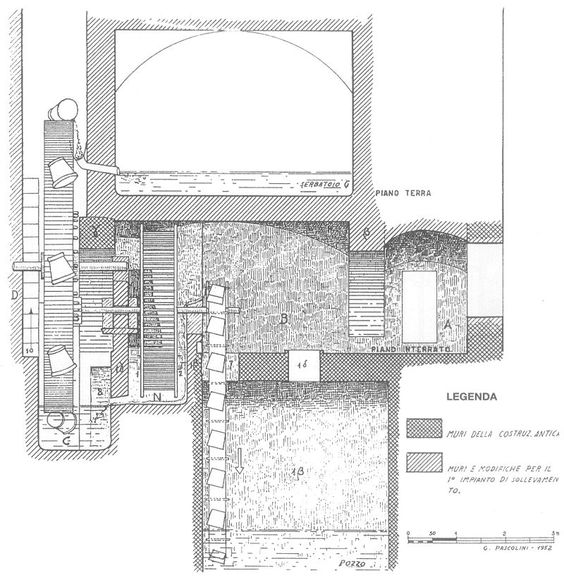 |
| exemple de Noria |
Ensuite durant le bas Empire les arches du premier niveau ont été murées de sorte que le bâtiment devennait forteresse. Cette transformation daterait du Ve ou VIe siècle, lorsque les Goths et les autres barbares ont envahi Ostie et surtout le Portus.
Regio II - Insula VII - Teatro (II,VII,2)
The excavators have divided Ostia into five regions, numbered I to V. Within the regions blocks (insulae) and individual buildings have been distinguished, numbered as follows: (region) I, (block) I, (building) 1, etcetera.
The theatre was built along the Decumanus Maximus. The outline could already be drawn in the early 19th century. It was excavated in the years 1880-1881, 1890, and in the early 20th century. The building was restored very extensively.
Fragments of an inscription tell us that a first theatre was built at the end of the first century BC by Agrippa, the right-hand man of Augustus (opus reticulatum and large tufa blocks). It could hold 3000 spectators. It was built together with a large square to the north, the Piazzale delle Corporazioni (II,VII,4).
 |
 |
The masonry of the present theatre has been dated to the late second century AD. In that period the theatre was enlarged, and could hold 4000 people. A large inscription from 196 AD (originally bronze letters inserted in a marble slab; found on the remains of the stage) tells us that this rebuilding was the work of Septimius Severus and Caracalla. Brick stamps however show that the work had been started by Commodus (176-192 AD).
Perhaps there is a relation with the curious re-founding of Ostia by Commodus as Colonia Felix Commodiana, probably in the years 190-192 AD (he also re-founded, with his own name, Lanuvium - where he was born -, and Rome). The theatre would have been a good location for celebrating the founding of his new colony. Commodus had close ties with gladiators, and he may well have appeared in the theatre as gladiator, or killing wild animals, as he did in Rome and Lanuvium. Commodus associated himself with Hercules, and in the theatre a stucco relief of Hercules, crowned by Victoria, was found. Did Commodus promise the rebuilding of the theatre at this occasion?
One ancient text probably refers to the Ostian theatre. In 197 AD Septimius Severus addressed the Senate in Rome and said: "For if it was disgraceful for him [Commodus] with his own hands to slay wild beasts, yet at Ostia only the other day one of your number, an old man who had been consul, was publicly sporting with a prostitute who imitated a leopard". This must be either a reference to the celebrations of the re-founding of Ostia by Commodus, or to the inauguration of the new theatre in 196 AD
Description
 |
The new theatre was made of brick. The facade is turned towards the street (Decumanus). In front are two nymphaea (II,VII,6-7). This area had a travertine pavement and was surrounded by travertine piers, between which were chains. In the facade are sixteen shops with back-rooms. The shops had simple wall-paintings. They were behind a portico, entered through arches. Between the arches were brick pilasters with travertine bases. There were also arches on the second and third level (on the highest level with windows). In the portico, to the right of the main entrance, is a well with a travertine well-head from the period of Commodus.The lower level of the seating area (cavea) could be entered from the Decumanus through a central corridor, and through two lateral entrances. The entrance in the centre of the row of shops had a pavement and wall revetment of marble. The vault was decorated with stucco reliefs. Four staircases between the shops led to the second and third level. The seating area could be shaded by an awning, suspended from poles inserted in travertine blocks. The seats themselves were probably covered with marble. On the third level were marble columns (now re-erected behind the stage; see the description of the Colonna con Genio).The area in front of the seating area (orchestra) had a marble floor. In the front of the stage are five semicircular and four rectangular niches, decorated with marble, including a cornice and small columns. Holes in the stage were used to fasten the scenery. The back wall of the stage has disappeared almost completely. On the stage some marble theatrical masks can now be seen, that once decorated the building.
At the end of the fourth century AD the building was restored by a prefect of the grain-supply, Ragonius Vincentius Celsus. A statue of Roma was in this period erected to the south-east of the theatre. The orchestra and the stage were connected through steps in two of the rectangular niches in the front of the stage. In the central corridor benches and an arch were built with bases from the Piazzale delle Corporazioni; the square was no longer being used for commercial purposes. The south part of the central entrance corridor and the two flanking shops with back-rooms were blocked and converted to cisterns, with hydraulic mortar (opus signinum). The orchestra could now be flooded for aquatic displays. The water reached the orchestra through two holes in the side walls of the northern part of the corridor. The pool was not very deep, 1.40 meters at most. Naval battles were of course not re-enacted. We should imagine a choreography of the gods and goddesses of the sea and lakes, of nymphs and Nereids, presumably scarcely dressed.
At a later point in time the arches of the first level were blocked, so that the building could be used as a fortress. This may have been done in the fifth or sixth century, when Goths and others invaded Ostia and especially Portus.







.jpg)
.jpg)
.jpg)
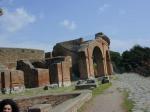
.JPG)
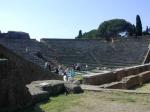
.jpg)
.jpg)
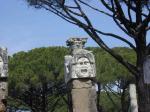
.jpg)
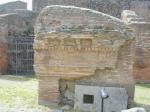


.jpg)
